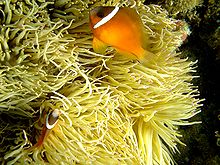Amphiprion barberi
| Amphiprion barberi | |
|---|---|
 |
|
|
Not evaluated (IUCN 3.1)
|
|
| Scientific classification | |
| Kingdom: | Animalia |
| Phylum: | Chordata |
| Superclass: | Osteichthyes |
| Class: | Actinopterygii |
| Order: | Perciformes |
| Family: | Pomacentridae |
| Subfamily: | Amphiprioninae |
| Genus: | Amphiprion |
| Species: | A. barberi |
| Binomial name | |
|
Amphiprion barberi (Allen, Drew & Kaufman, 2008) |
|
Amphiprion barberi, is a species of anemonefish that is found in the is found in the western Pacific Ocean.. It was previously considered a geographic color variation of other anemonefish, initially Amphiprion rubrocinctus from 1972 and then Amphiprion melanopus from 1980 however further study and DNA sequencing resulted in A. barberi being described as a new species in 2008. Like all anemonefishes it forms a symbiotic mutualism with sea anemones and is unaffected by the stinging tentacles of the host anemone. It is a sequential hermaphrodite with a strict sized based dominance hierarchy: the female is largest, the breeding male is second largest, and the male non-breeders get progressively smaller as the hierarchy descends. They exhibit protandry, meaning the breeding male will change to female if the sole breeding female dies, with the largest non-breeder becomes the breeding male. The fish's natural diet includes zooplankton.
The body of adults are generally red-orange with a single white bar. The snout and breast are orange. Each of the caudal, dorsal and anal fins are orange. They have 10 dorsal spines, 2 anal spines, 16-18 dorsal soft rays and 14 anal soft rays. They reach a maximum length of 8.5 cm (3 1⁄4 in).
Some anemonefish species have color variations based on geographic location, sex and host anemone. A. barberi does not show any of these variations.
A. rubrocinctus and A. melanopus are geographically distinct. A. rubrocinctus are limited to north western Australia. A melanopus is widely distributed in the western Pacific, from the Great Barrier Reef north to the Marshall Islands and Guam, New Guinea and from Vanuatu and New Caledonia to eastern Indonesia. There are significant color-pattern differences, with A. melanopus having a dark brown or blackish body, compared to the red orange of A. barberi. A. melanopus also has 19-26 spines in the upper-opercular series while A. barberi has only 11-19.
...
Wikipedia
